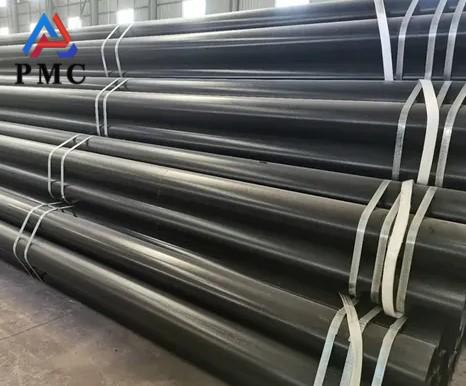
Material Re-inspection of SMLS Pipe
Material re-inspection of SMLS pipes (seamless pipe) refers to the re-inspection of the material (chemical composition and mechanical properties) of the steel pipes when they arrive at the user's site, or during the production process or before storage, to verify whether they meet the requirements of the purchase contract and relevant standards. This is usually carried out when there are doubts about the quality of the steel pipes, doubts about the original factory warranty, or mandatory re-inspection requirements for the project. The following is a carefully summarized information related to the material re-inspection of SMLS pipes.
Why is material re-inspection necessary?
1. Verify manufacturer warranties: Ensure that quality certificates provided by suppliers match the actual product to prevent false or inaccurate information.
2. Avoid material confusion: During storage, transportation or construction, steel pipes from different batches and brands may be confused, and re-inspection can effectively distinguish them.
3. Ensure project safety: For steel pipes involving high pressure, high temperature, corrosive media or serving as key structural components, the conformity of the material is directly related to the safety and reliability of the project.
4. Meet regulatory requirements: Many national standards, industry specifications or specific engineering projects (especially pressure piping, nuclear power, aerospace, etc.) require mandatory re-inspection of incoming materials.
5. Traceability and claims: The re-inspection results can be used as evidence of product quality problems and provide a basis for subsequent traceability and claims.
Material re-inspection items
The re-inspection of seamless steel pipe material mainly includes the following items:
1. Chemical composition analysis
Purpose: To verify whether the content of various elements in steel meets the standard requirements, which is the basis for determining the steel grade and performance.
Detection method:
Spectroscopic analysis method: Commonly used is direct reading spectrometer (OES), which analyzes the sample surface through spark discharge and quickly determines the content of multiple elements.
Chemical analysis method: Wet chemical analysis is used, which has higher accuracy and is often used for arbitration analysis.
X-ray fluorescence spectrometry (XRF): suitable for non-destructive and rapid analysis.
Main elements: carbon (C), silicon (Si), manganese (Mn), phosphorus (P), sulfur (S), etc., as well as alloying elements (chromium Cr, nickel Ni, molybdenum Mo, vanadium V, titanium Ti, etc.).
2. Mechanical properties test
Purpose: To verify whether the strength, plasticity and toughness of the steel pipe meet the standard requirements.
Test items:
Tensile test: Determine the tensile strength (Rm/σb), yield strength (ReH/σs), and elongation after fracture (A/% or δ%).
Impact test: Determine the impact absorption energy (KV2) and evaluate the toughness of the material at low temperatures (commonly used for steel pipes with low temperature requirements).
Hardness test: Determine the Brinell hardness (HBW), Rockwell hardness (HRC) or Vickers hardness (HV), which reflects the material's ability to resist plastic deformation.

3. Process performance inspection (part)
Flattening test: checks the plasticity and deformation capacity of steel pipes, usually used to evaluate the performance of pipes under transverse compression.
Expansion test: Check the plastic deformation capacity of the steel pipe end, commonly used for small diameter pipes.
Bending test: Check the plasticity of the material and its ability to withstand bending deformation.
4. Metallographic inspection (some high-requirement steel pipes)
Purpose: To inspect the microstructure, grain size, non-metallic inclusions, decarburized layer, etc. of steel pipes and evaluate the metallurgical quality of the materials.
For stainless steel, intergranular corrosion testing may also be performed to evaluate its resistance to intergranular corrosion.
Batch grouping rules and sampling for re-inspection
Re-inspection usually follows the batching rules and sampling quantities specified in the corresponding standards:
Batch rules: Each batch of re-inspected steel pipes should be composed of steel pipes of the same brand, same furnace number, same specifications (outer diameter, wall thickness), same production process and same heat treatment system (furnace). The number of steel pipes in each batch usually has an upper limit (for example, 200 pieces of D≤114.3mm, 50 pieces of D>325mm, etc.).
Sampling quantity: A specified number of steel pipes are taken from each batch for inspection, and corresponding specimens are cut from these steel pipes for various tests. The specific sampling quantity will vary according to different standards and test items.
Re-examination judgment rules
Failure of initial inspection: If any item in the initial inspection result does not meet the standard requirements, double the number of re-inspections should be carried out for the unqualified item.
Re-test qualified: If the results of all re-test samples are qualified, the batch of steel pipes is judged to be qualified.
Re-inspection failure: If any item in the re-inspection result is still unqualified, the batch of steel pipes will be judged as unqualified. The supplier can inspect the batch of steel pipes one by one and eliminate the unqualified ones; or re-heat treat the entire batch of steel pipes and re-submit them for inspection as a new batch (re-heat treatment is usually only allowed once).
Read more: Passivation Treatment Time of SMLS Pipe
- 【Prev】 : ATSM A53 Pipe vs API 5L Pipe
- 【Next】 : Rust Removal Methods for Seamless Square Tubes


